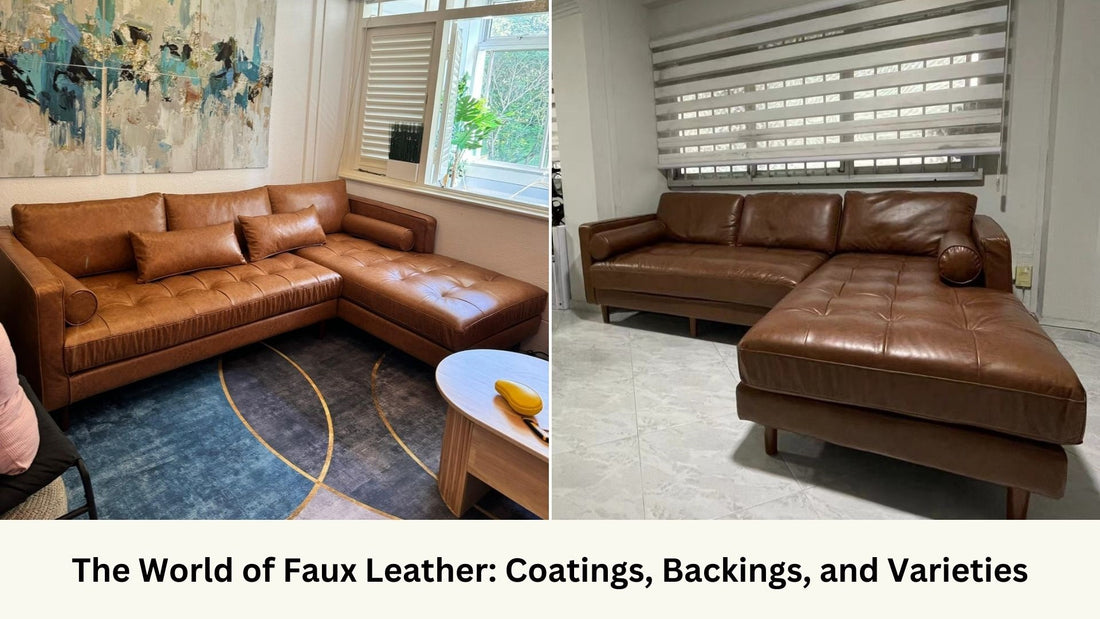
The World of Faux Leather: Coatings, Backings, and Varieties
Share
Faux leather, also known as synthetic leather or vegan leather, has become an increasingly popular alternative to genuine leather. It mimics the appearance and feel of natural leather, offering a cost-effective and animal-friendly solution. Faux leather is essentially made up of two primary components: coating and backing. These two layers come together to create the various types of faux leather seen in furniture, fashion, and automotive applications.
Key Components of Faux Leather: Coating and Backing
-
Coating:
The coating refers to the synthetic layer that gives faux leather its leather-like appearance and texture. It's responsible for the product's durability, feel, and resistance to elements like water and wear. The most common materials for this coating are PVC (polyvinyl chloride), PU (polyurethane), and silicone. -
Backing:
The backing is the fabric base that supports the synthetic coating. It provides structure and durability, influencing how flexible or strong the faux leather feels. The backing can be made from woven or non-woven fabrics.
When these two elements combine — synthetic coating on top of a fabric backing — they form the faux leathers we know today. The quality of faux leather depends on the composition and how well these two layers bond.
Different Types of Coatings
Faux leather coatings are crafted from various materials, each offering distinct properties. Let's explore the three main types: PVC, PU, and silicone.
-
PVC (Polyvinyl Chloride):
PVC was one of the earliest synthetic leather coatings, developed in the 1920s. Its composition includes plasticizers that make it flexible, while the vinyl element provides waterproofing and durability. -
PU (Polyurethane):
PU emerged as a more flexible and eco-friendly alternative to PVC in the mid-20th century. Its composition involves multiple layers of polyurethane, which are applied to a fabric base. Unlike PVC, PU is softer and more breathable. -
Silicone:
Silicone-coated faux leather is a relatively recent innovation, valued for its hypoallergenic and environmentally friendly properties. Silicone is a rubber-like polymer that creates a coating that is highly durable and safe for sensitive skin.
Different Types of Fabric Backings
The backing fabric is an essential part of faux leather’s overall structure, contributing to its strength and flexibility. There are two main categories of backing: woven and non-woven.
-
Woven Fabric Backing:
Woven backings are made by interlacing fibers together to create a textile structure, much like traditional fabrics. This method produces a durable, strong base. -
Non-Woven Fabric Backing:
Non-woven backings are made by bonding fibers together rather than weaving them. This results in a lighter, softer fabric and is commonly used when flexibility is important.
Common Terms and What They Represent
In the world of faux leather, several terms represent specific variations or marketing names for synthetic leather products. Here’s a breakdown of some commonly heard terms:
-
Microfibre Leather:
A type of faux leather made from an enhanced PU (polyurethane) coating and a non-woven microfiber backing. It offers a realistic leather feel, making it a higher-quality alternative to standard faux leather. -
Leathaire:
A synthetic faux leather material engineered to be breathable and soft to the touch, designed to look and feel like leather. Leathaire's breathability comes from the inclusion of microperforations in its structure, which allow air molecules but not water molecules to pass through easily, enhancing comfort. -
Leatherette:
A general term for faux leather, typically made from PU or PVC. It mimics the look and feel of genuine leather without using animal products. -
Pleather:
A portmanteau of "plastic" and "leather," pleather refers to faux leather made primarily from PVC. It is a lower-cost alternative to genuine leather, with a distinctive plastic-based composition.
Published: 23rd Oct 2024
